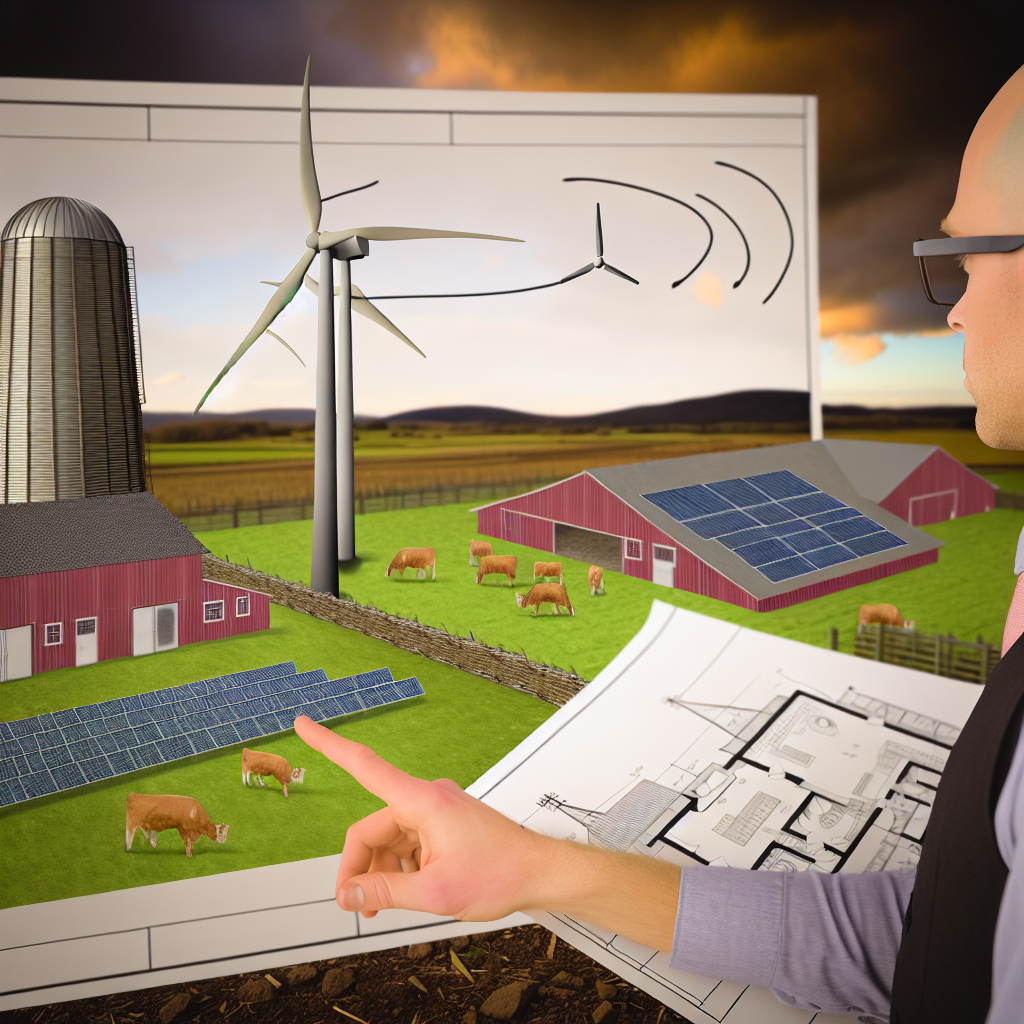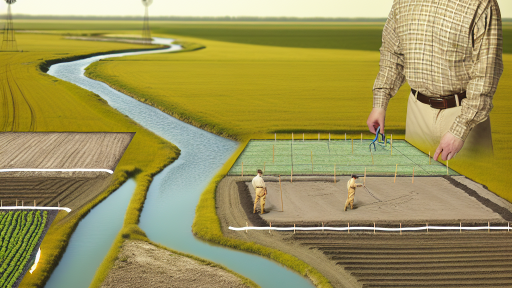Introduction to Renewable Energy in Agriculture
Understanding Renewable Energy
Renewable energy refers to energy derived from natural sources that are replenished constantly.
This includes solar, wind, geothermal, and biomass energy.
These sources play a crucial role in modern farming practices.
Farmers increasingly adopt renewable energy solutions to enhance sustainability efforts.
Benefits of Renewable Energy in Farming
Renewable energy can significantly reduce operational costs for farmers.
It lowers dependence on fossil fuels, which are often volatile in price.
Additionally, using renewable sources mitigates environmental impacts.
Notably, this shifts agriculture toward lower greenhouse gas emissions.
Integration into Farm Planning
Incorporating renewable energy into farm designs requires careful planning.
First, farmers should assess their specific energy needs.
Next, they must evaluate suitable renewable technologies available.
Finally, integrating these technologies into their infrastructure is essential.
Case Studies and Examples
One effective example is solar panel installation on barn rooftops.
This strategy generates electricity for farm operations while saving costs.
Wind turbines also provide sustainable energy in rural areas.
Transform Your Agribusiness
Unlock your farm's potential with expert advice tailored to your needs. Get actionable steps that drive real results.
Get StartedFurthermore, biogas systems convert manure into usable energy.
Future Considerations
The future of agriculture lies in the widespread adoption of renewable energy.
Farmers must stay updated on incentives and funding opportunities available.
Continuous education about renewable technologies enhances implementation success.
Ultimately, adopting these methods leads to a sustainable agricultural future.
Benefits of Integrating Renewable Energy in Farm Designs
Cost Savings
Integrating renewable energy reduces operational costs for farmers.
Solar panels and wind turbines often provide free energy after installation.
In the long run, these installations lower utility bills significantly.
Farmers can reinvest the savings into sustainable practices.
Energy Independence
Renewable energy offers farmers greater energy independence.
They rely less on external energy suppliers and fluctuating fossil fuel prices.
This autonomy enhances overall farm stability and resilience.
Environmental Benefits
Utilizing renewable energy minimizes carbon footprints.
This practice contributes positively to climate change mitigation.
Moreover, it supports wildlife and preserves biodiversity on farms.
Enhanced Operational Efficiency
Renewable energy systems can improve overall farm efficiency.
Electricity from solar or wind power can be used for irrigation and equipment.
This reduces reliance on non-renewable energy sources.
Consequently, productivity tends to increase with these innovations.
Attracting Eco-Conscious Consumers
Modern consumers are increasingly interested in sustainable products.
By adopting renewable energy, farms appeal to environmentally-minded shoppers.
This shift can enhance brand loyalty and market positioning.
Government Incentives
Farmers can often benefit from government incentives for renewable energy.
Tax credits and grants can offset installation costs significantly.
Showcase Your Farming Business
Publish your professional farming services profile on our blog for a one-time fee of $200 and reach a dedicated audience of farmers and agribusiness owners.
Publish Your ProfileAdditionally, various programs support ongoing maintenance and upgrades.
Assessment of Energy Needs for Different Farm Types
Understanding Energy Requirements
Each farm type has unique energy needs.
These needs depend on the specific operations conducted.
For instance, crop farms may require energy for irrigation systems.
Livestock farms need energy for feeding and watering operations.
Understanding these requirements is crucial for efficient planning.
Crops and Energy Consumption
Crop farms vary in their energy demands based on farming methods.
Conventional farming typically consumes more energy than organic farming.
Modern equipment and technology contribute to higher energy use.
Farmers should evaluate their energy sources and consumption closely.
Using renewable energy can significantly reduce costs in the long run.
Livestock Operations and Their Needs
Livestock operations have distinct energy requirements.
Energy is essential for heating, cooling, and feeding livestock.
Additionally, automated systems enhance efficiency but require more energy.
Farmers should analyze their energy footprint regularly.
Implementing energy-efficient practices can lead to substantial savings.
Specialty Crop and Organic Farms
Specialty crop farms often require niche energy solutions.
These farms may utilize greenhouses which have specific energy demands.
Organic farms, while generally lower in energy needs, also benefit from efficiency.
Assessing their energy use can guide better decision-making.
Adopting sustainable practices increases resilience and helps meet energy needs.
Integrating Renewable Energy Solutions
Farmers should consider integrating renewable energy sources.
Solar panels can provide energy for various farm operations.
Wind turbines may also offer significant energy savings in certain areas.
Biomass energy solutions can be particularly effective on livestock farms.
Investing in renewable solutions promotes sustainability and reduces dependency on fossil fuels.
Find Out More: Water Conservation Strategies In Sustainable Farm Design
Types of Renewable Energy Sources Suitable for Farms
Solar Energy
Solar energy utilizes sunlight to generate electricity or heat.
Farmers can install solar panels on rooftops or open fields.
This method reduces reliance on fossil fuels significantly.
Additionally, solar energy can power farm equipment directly.
Many farmers experience lower energy costs after installation.
Wind Energy
Wind energy harnesses the power of moving air to generate electricity.
Tall wind turbines installed on farms can capture strong winds.
This form of energy is especially effective in open areas.
Farmers can sell excess energy back to the grid.
Furthermore, wind energy systems require low maintenance.
Biogas
Biogas production involves converting organic waste into energy.
Farmers can use livestock manure and crop residues for this purpose.
This process reduces waste while generating renewable energy.
Showcase Your Farming Business
Publish your professional farming services profile on our blog for a one-time fee of $200 and reach a dedicated audience of farmers and agribusiness owners.
Publish Your ProfileBiogas systems can provide heating and electricity for farm operations.
Moreover, they contribute to improved soil health through nutrient recycling.
Hydropower
Hydropower generates energy from flowing water in streams or rivers.
Farmers with water access can install small-scale turbines.
This renewable source can provide reliable and continuous power.
Additionally, it can enhance irrigation systems on the farm.
Hydropower has minimal environmental impact when managed properly.
Geothermal Energy
Geothermal energy taps into the Earth’s internal heat.
This energy source can heat buildings and greenhouses effectively.
Moreover, it supports temperature control for livestock and crops.
Geothermal systems typically have long operational lifespans.
Farmers can benefit from lower heating costs over time.
Gain More Insights: Advantages of Diverse Crop Systems
Case Studies: Successful Integration of Renewable Energy in Farming
Solar Energy Initiatives
Farmers in California have adopted solar panels on their rooftops.
This initiative reduces their electricity costs significantly.
For instance, Green Valley Farms increased their energy efficiency by 40% last year.
Moreover, they receive incentives from the state for their solar investments.
This combination of savings and incentives boosts their bottom line.
Wind Energy Applications
Wind energy presents another viable option for farmers.
In Texas, the Johnson Family Farm installed a wind turbine on their property.
This turbine generates sufficient energy to power their entire operation.
As a result, they reduced their reliance on fossil fuels.
Additionally, they sell excess energy back to the grid.
Biomass and Agricultural Waste Utilization
Farmers can turn agricultural waste into renewable energy sources.
For example, Willow Creek Orchard uses apple pomace to produce biogas.
This biogas fuels their heating systems and machinery.
Consequently, they not only cut energy costs but also minimize waste.
Case Study: Maplewood Farm
Maplewood Farm in Oregon integrates various renewable energy solutions.
They rely on solar panels, wind turbines, and biomass energy.
This diverse approach ensures consistent energy supply throughout the year.
As a result, they achieved a 50% reduction in grid electricity usage.
Furthermore, their commitment to sustainability strengthens their brand image.
Challenges Overcome
Integrating renewable energy does present challenges.
High initial costs can deter some farmers from making the switch.
However, numerous grants and financing options are available.
Farmers often find long-term savings outweigh initial investments.
Additionally, some face technical knowledge gaps regarding installation.
Partnering with renewable energy firms can alleviate these concerns.
Future Outlook
The future of farming is undeniably linked to renewable energy integration.
Farmers are increasingly seeking sustainable practices to enhance resilience.
Showcase Your Farming Business
Publish your professional farming services profile on our blog for a one-time fee of $200 and reach a dedicated audience of farmers and agribusiness owners.
Publish Your ProfileAs technology advances, costs will likely decrease further.
Thus, more farmers will adopt these energy solutions in the coming years.
Renewable energy integration offers a pathway for sustainable agriculture.
See Related Content: Gray Water Recycling Techniques for Agricultural Use
Challenges and Barriers to Renewable Energy Adoption in Agriculture
Financial Constraints
Many farmers face significant financial obstacles in adopting renewable energy solutions.
Initial investment costs can deter even the most committed agriculturalists.
Moreover, access to financing options is often limited, complicating decision-making.
In addition, fluctuations in commodity prices can exacerbate financial uncertainty.
Technical Knowledge and Skills Gap
A lack of technical expertise can hinder the implementation of renewable technologies.
Many farmers are not familiar with the latest energy-efficient practices.
This knowledge gap contributes to inefficient energy use and missed opportunities.
Training programs can help, but participation rates are often low.
Regulatory Barriers
Complex regulations can pose significant challenges to renewable energy adoption.
Farmers often struggle to navigate zoning laws and permitting processes.
Inconsistent policies can create uncertainty and discourage investment.
Additionally, some areas lack supportive incentives for renewable energy initiatives.
Market Access and Competition
Access to markets for renewable energy products can limit farmer participation.
Farmers may face stiff competition from larger agribusinesses.
This competition can make it difficult for smaller producers to enter the market.
Establishing fair market practices can help level the playing field.
Cultural Perceptions and Resistance to Change
Some farmers may have cultural attachments to traditional energy sources.
Resistance to change can stem from fear of the unknown or potential risk.
Engaging communities and showcasing successful examples can help overcome this resistance.
Moreover, tailored outreach programs can change perceptions around renewable technologies.
Infrastructure Limitations
Many rural areas lack the necessary infrastructure to support renewable energy systems.
Insufficient grid connectivity can hinder the distribution of generated energy.
Upgrading infrastructure can require significant financial investment and planning.
Collaboration between farmers and local governments can address these challenges.
Delve into the Subject: Integrating Circular Economy in Farm Waste Management

Government Policies and Incentives for Renewable Energy on Farms
Federal Incentives and Programs
Farmers can benefit from various federal programs supporting renewable energy integration.
The USDA offers grants under the Rural Energy for America Program.
This program helps cover the cost of renewable energy systems.
Additionally, the Investment Tax Credit provides tax relief for solar energy investments.
Farmers can receive up to 26% of installation costs as a tax credit.
State-Level Initiatives
Many states offer their own programs to encourage renewable energy use in agriculture.
For instance, California’s SGIP program provides incentives for energy storage systems.
Similarly, New York has a Solar Energy Incentive Program for agricultural producers.
These state initiatives often complement federal efforts.
Farmers should research their state programs for specific benefits.
Regulatory Support
Government regulations play a crucial role in promoting renewable energy on farms.
Showcase Your Farming Business
Publish your professional farming services profile on our blog for a one-time fee of $200 and reach a dedicated audience of farmers and agribusiness owners.
Publish Your ProfileIncentives often include reduced permitting fees for renewable installations.
Some states streamline the permitting process for renewable projects.
This reduces delays and encourages farmers to adopt sustainable practices.
Funding Opportunities
Farmers can access various funding sources for renewable energy projects.
These include low-interest loans and grants from government agencies.
Community banks and credit unions often support renewable farming initiatives.
Farmers should explore local and national funding options available.
Education and Outreach Programs
Governments promote renewable energy adoption through educational programs.
These initiatives help farmers understand available technologies and incentives.
Workshops, online courses, and informational resources are readily available.
Participating in these programs can enhance farmers’ knowledge and confidence.
Local Government Initiatives
Local governments also contribute to renewable energy efforts in agriculture.
They may offer property tax exemptions for renewable energy installations.
Some municipalities facilitate local renewable energy cooperatives.
Farmers can collaborate on community solar projects and share resources.
Future Trends in Renewable Energy Technologies for Agriculture
Emerging Technological Innovations
Recent advancements in renewable energy technologies reshape agriculture.
Solar panels with enhanced efficiency now capture more sunlight.
Wind turbines are becoming smaller and more efficient for farms.
Biogas technology transforms agricultural waste into valuable energy.
Farmers can now harness geothermal energy for heating purposes.
Integration with Precision Agriculture
Smart farming utilizes renewable energy for real-time data collection.
GPS technology helps farmers optimize energy use on fields.
Data-driven apps connect irrigation systems to renewable energy sources.
This integration enhances overall crop productivity and sustainability.
Sustainability and Economic Benefits
Using renewable energy reduces operational costs for farmers.
It promotes sustainability by lowering carbon footprints.
Farmers gain energy security through local energy production.
This self-sufficiency ultimately boosts rural economies.
Regulatory Support and Incentives
Various governments now provide incentives for renewable energy adoption.
Grants and subsidies encourage farms to install solar and wind systems.
Supportive policies foster innovative financing mechanisms.
Farmers benefit from reduced upfront and long-term costs.
Future Prospects and Market Growth
The renewable energy market in agriculture is expected to grow rapidly.
Investments in clean energy technologies are on the rise.
This growth will drive further advancements and research.
Consequently, continuous improvements will emerge in energy systems.
Practical Steps for Farmers to Implement Renewable Energy Solutions
Assess Energy Needs
Farmers should start by assessing their energy consumption patterns.
Identify which operations consume the most electricity.
Consider seasonal variations in energy use throughout the year.
Research Renewable Energy Options
Explore various renewable energy sources available for farms.
Showcase Your Farming Business
Publish your professional farming services profile on our blog for a one-time fee of $200 and reach a dedicated audience of farmers and agribusiness owners.
Publish Your ProfileSolar energy is a popular choice due to its versatility.
Wind energy may be suitable for farms in open areas.
Biomass can be beneficial for farms with livestock or crop waste.
Conduct a Feasibility Study
After choosing a renewable energy type, conduct a feasibility study.
This study evaluates potential site requirements and logistical aspects.
Assess the initial investment costs and possible returns on investment.
Analyze local regulations regarding renewable energy installations.
Secure Financing and Grants
Investigate available financing options for renewable energy projects.
Look for government grants or subsidies for renewable energy adoption.
Consider working with local banks or credit unions for loans.
Collaborate with Renewable Energy Providers
Identify reputable renewable energy providers for your project.
Request proposals from multiple companies to compare options.
Evaluate providers based on price, service, and track record.
Plan for Installation and Maintenance
Once you’ve selected a provider, plan for the installation process.
Set a timeline for installation to minimize disruptions.
Establish a long-term maintenance plan to ensure system efficiency.
Monitor Your Energy Production and Consumption
Once the system is operational, continuously monitor its performance.
Track energy production against consumption regularly.
Adjust operational practices based on data collected.
Educate Staff and Community
Educate farm staff on the benefits of renewable energy systems.
Share knowledge with the local community to promote sustainability.
Engage in discussions about the importance of renewable energy.
Additional Resources
The 5 Cs of Agrivoltaic Success Factors in the United States …




